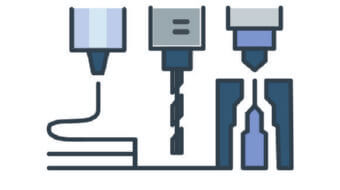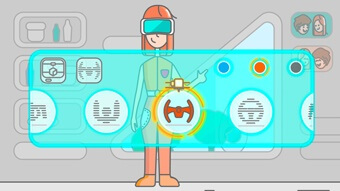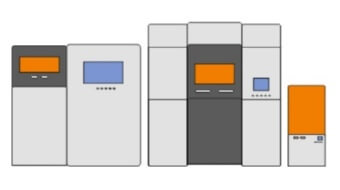CNC stands for Computer Numerical Control, a way of automating a machine. If ordinary equipment requires manual labor, in CNC a computer controls machines to perform tasks. Another common feature of all CNC machines is that they can move their tools in at least two different directions. The directions are called axes and the more of those a machine has, the more complicated it is. There are three possible linear axes: X, Y and Z, and three additional rotary axes: A, B and C.
- How do CNC machines work?
- Types of CNC machines
- What is a Mechanical Milling CNC machine?
- What is a CNC Lathe or a Turning machine?
- What is a Laser Cutter?
- What is a Plasma Cutter?
- What is an Oxyfuel Cutter?
- What is an Electric Discharge Machining (EDM)?
- What is a Water Jet Cutting Machine?
- What Other CNCs are there?
How do CNC machines work?
All CNC machines perform tasks according to a code, which tells them how to move, rotate and use the different tools. The code is a step-by-step instruction with specific coordinates and commands that a CNC machine can read and follow. With the addition of automation to machine shops, a whole new field of profession was born. CNC machinists operate these units through CNC programming, as well as provide general maintenance for tools. However, highly complicated jobs would be laborious and time-consuming so to speed things up and avoid mistakes, a Computer-aided manufacturing (CAM) system can be used.
CAM is computer software used to create codes for CNC machines. Usually, this software works with a Computer-aided design (CAD) of an object that needs to be produced with a CNC machine. An engineer would only need to detail the operations and working parameters. After a code is ready, it's sent to the machine to start the process.
Additionally, based on the 3D design it is possible to get a full grasp on how a certain part can be cut from a work piece, and even get an instant cost calculations.
Types of CNC machines
There are plenty of CNC machines today, from small to huge, with their own specialized use cases. Some of these machines are created for one or two specific tasks only, while others (like modern machining systems and centers) can perform various operations which even include changing the tools themselves. Still, there are several groups of widely used CNC machines that should be mentioned.
What is a Mechanical Milling CNC machine?
The critical function of milling CNC machines is simple - to remove the material with a milling cutter. A milling group of CNC machines exists to mill, drill, tap, finish, and turn an object or a block of material. It ranges from simple desktop CNC routers and plotters, which can cut a form or drill a hole in soft foam, to industrial monsters capable of forming objects close to art. The combination of different mechanical cutting tools and computer commands makes it possible to produce amazing 3D objects from wood, metal, wax and many other materials depending on the machine's RPM and tooling. Complex CNC milling centers can even switch the mills themselves to perform several operations in one go. Different effects are reached by using a suitable form, material of a mill and a machine function.
What is a CNC Lathe or a Turning machine?
Lathes are similar to milling machines - they are also made to cut and remove material. The core difference is that lathes rotate workpieces (usually horizontally) while drilling or cutting them. CNC lathes cut objects quickly, and most of the old models have only two axes – X and Z – which are enough for specific jobs. Because both workpiece and mill can rotate at the same time, a cutting tool is capable of making a smooth radially-symmetrical cut across the whole cylinder. 2-axis CNC Lathes are widely used to process cylindrical pieces of material, which need symmetrical patterns or curving across the radius. Modern turning centers can have more axes or utilize live tooling to perform advanced jobs like in the video below.
What is a Laser Cutter?
Laser cutting CNC machines appeared around 1965 and are used to cut, polish, melt and engrave materials. Their capabilities are pretty similar to milling and turning machines, but the decisive difference is in the primary tool – instead of mechanical mills, a laser is used. With CNC control and optics, a laser beam is directed through a workpiece to perform the required processes. Lasers range by type, power capabilities and gas flow support. Depending on the specifications, such machines can work with paper, acrylics, glass, metals and much more. Compared with mechanical cutting tools, CNC laser cutters are considered to be easier to work with and cause less contamination to a material. Laser cutters and engravers became a popular tool for small businesses and hobbies since many units can fit a simple workshop and not break a bank. Strong lasers can also be more precise than a mill because the platter becomes damaged or deformed over time whereas lasers are more durable and long-lasting. In performing some tasks, laser cutters are also up to 30 times faster than traditional mechanical saws. However, some laser cutters require much more energy to operate – it’s called heat input and depends on the type of job, laser, material, workpiece thickness, etc.
What is a Plasma Cutter?
To the naked eye, CNC plasma cutters may seem pretty similar to laser cutters – they also cut and melt materials, and their plasma torch looks like a laser ray from the side. However, the plasma cutting method was invented later and its working principle and specifications are a little different. The process of plasma cutting is possible with electrically conductive materials – like steel and some other metals. Hot plasma is created by forming an electrical arc through gas, blown at high speed out of a nozzle. CNC plasma cutting machines use more energy compared to their laser counterparts. But as an advantage, plasma is capable of cutting thicker sheets of metal while industrial lasers required for the same job cost much more. Some old plasma cutters aren't as precise as lasers but there are newer models with improved torches which operate accurately.
What is an Oxyfuel Cutter?
CNC oxyfuel cutters share a technique that is extremely close to plasma cutting – many modern machines can even perform both techniques. Working tools in oxyfuel cutting machines are fuel, gas and oxygen. To begin, a torch heats a metal material to its kindling temperature – the lowest point where it can become inflammable. In that condition, metal can react with a direct stream of oxygen, turning into a metal oxide. Basically, CNC oxyfuel cutters blow the oxygen jet onto a heated workpiece to cut it. Oxyfuel cutters may leave rough edges from the cuts, but they are great for working with thick metal blocks – some are capable of cutting metal 40 inches (1000 mm) thick.
What is an Electric Discharge Machining (EDM)?
Electric Discharge Machining is where the main tool a CNC machine operates with is electrical discharges, which causes lots of sparks to appear and led to some people opting to call EDM spark machining. EDM Machines commonly have two electrodes that generate discharges between them – by a series of such rapid "sparks" a machine removes material from a workpiece. One electrode is located on the top and is called the tool, the second electrode lies under the block of material and is called the workpiece. These two working parts are separated by dielectric fluid. Machines of such type are called Die-sink EDM. There are also Wire EDM cutting machines – their tool is a wire connected to two electrodes. Using a wire, the CNC machine cuts a form out of a workpiece according to the uploaded code. EDM CNC machines are used for creating prototypes and molds. Their great advantage is extreme precision – cuts can be thin and nearly invisible in a solid block of the material. Electrodes used as tools in EDM units can vary by form and size, which makes it possible to drill holes, curves, and forms for different applications. EDM process can work with different conductive (or non-conductive with special setup) materials, including hard and soft, which can't be machined with other types of CNC technologies. Small-scale jobs are also performed better with this method because there is no excess pressure from a cutting tool.
On the contrary, EDM machining is considered quite dangerous due to the use of oil-based fluids which are highly flammable. The process is quite slow and power-consuming compared to some other methods. Tools in EDM machines wear out during jobs, and it may take time and money to create new electrodes for a specific machine.
What is a Water Jet Cutting Machine?
As the name implies, Water Jet cutting machines use water to remove material from a workpiece, as well as shape and cut it in a different form. The water (sometimes mixed with an abrasive substance) is streamed under high pressure and directed by a Numerical Control. This method can be used to cut metals and granite as well – with abrasive materials added for stronger materials and pure water for cutting softer structures such as wood, rubber and foam. Complex units with several axes can cut a workpiece in all three dimensions and produce complicated structures. Water Jet CNC machines commonly don't need any heating or a material or a tool, which helps to avoid material deformity or contamination and makes them a preferred method while working with gentle materials.
What Other CNCs are there?
As Computer Numerical Control is just a way of automating different tools for various operations, a wide range of machines is currently available on the market. New tools, materials, and methods of performing a certain task give birth to new CNC machines like 3D printers and others. Machine manufacturers also create custom CNC units and systems for special needs of production to automate nearly every step of fabrication. To mention a few – there are sewing and embroidering CNC machines, picking and loading, jewelry faceting and polishing machines too.






